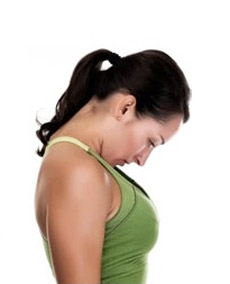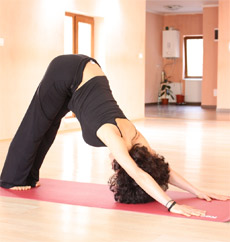|
|
Exercises to Overcome Flabby Neck
 Generally
we do exercises for physical fitness,
build muscle
strength,
physiological well-being and
strengthening the immune
system.
There are a number of exercises and
techniques for each and every part of
the body. The general focus would be loose
weight, relaxation,
increase stamina, body
building, rejuvenation etc. Generally
we do exercises for physical fitness,
build muscle
strength,
physiological well-being and
strengthening the immune
system.
There are a number of exercises and
techniques for each and every part of
the body. The general focus would be loose
weight, relaxation,
increase stamina, body
building, rejuvenation etc.
Neck is the one part of the body that is
neglected often, people do not show
inclination or the necessity to do
exercises for the neck. Neck
exercises are
as important as any other exercises. It
is very important that the neck muscles
be well developed to get a firm,
flexible and strong neck. Young girls
and women we see these days are obsessed
with long necks. Nobody is born with a
long neck. The reason why many people
have short and stout necks is because
they forget to exercise the neck
muscles, resulting in the flabby neck.
The following exercises will help you
develop strong and flexible neck.
Neck Bend
-
 Stand straight with feet
together, rest the hands on the
hips, slowly bend the neck forward,
touch the chest with the chin, stay
for 20 seconds. Bring the head back
to the resting position. Stand straight with feet
together, rest the hands on the
hips, slowly bend the neck forward,
touch the chest with the chin, stay
for 20 seconds. Bring the head back
to the resting position.
-
Stand straight with feet
together, rest the hands on the
hips, slowly bend the neck backward,
looking towards the ceiling, stay
for 20 seconds. Bring the head back
to the resting position.
-
Repeat the above exercise for 20
count.
-
Stand straight, rest the hands
on the hips, slowly bend the neck to
the right, right ear almost touching
the right shoulder, stay for 20
seconds. Bring the head back to the
resting position.
-
Stand straight, rest the hands
on the hips, slowly bend the neck to
the left, left ear almost touching
the left shoulder, stay for 20
seconds. Bring the head back to the
resting position.
-
Repeat the exercise for 20
count.
Neck Rotation
-
Stand straight, rest the hands
on the hips, rotate the head in the
clockwise motion for 10 counts.
-
Stand straight, rest the hands
on the hips, rotate the head in the
anticlockwise motion for 10 counts.
-
As one gets comfortable with the
exercises, the count can be
increased to 50.
People tend to hold a lot of tension in their neck and shoulders, which causes the neck muscles to tighten and shorten. Releasing this tension will increase the length of the neck muscles, as will other neck stretching exercises.
|
Neck Stretch
Sit up straight in a chair and look in a
mirror. Position the neck so that it is
directly straight over your shoulders.
Your chin should be level and parallel
to the floor. Lift the neck up
high and imagine that you are stretching
your neck up to the ceiling. Hold the
neck stretched up for three to five
seconds. Do five to 10 reps.
Yoga & Your Neck
 Yoga can help relax tight and shortened
neck muscles. You are often told to hold
your neck in a "long neck" position
during yoga
poses.
The downward
facing dog pose
is a good exercise to lengthen your
neck because your body is inverted and
gravity will help pull it down. Lie flat
on your stomach with your legs hip-width
apart and place your hands next to your
ribs below your armpits. Push your body
up so that your hips are in the air and
your legs and arms are straight. Your
body will resemble an upside "V." Relax
your neck down so it is in line with
your spine and arms. Try to straighten
your knees and shift your hips back.
Squeeze your abs and
flatten your back.
Pull your shoulders away from your ears.
This will help get your neck into a
straight alignment and help it lengthen.
Hold for five deep breaths or at least
30 seconds. Yoga can help relax tight and shortened
neck muscles. You are often told to hold
your neck in a "long neck" position
during yoga
poses.
The downward
facing dog pose
is a good exercise to lengthen your
neck because your body is inverted and
gravity will help pull it down. Lie flat
on your stomach with your legs hip-width
apart and place your hands next to your
ribs below your armpits. Push your body
up so that your hips are in the air and
your legs and arms are straight. Your
body will resemble an upside "V." Relax
your neck down so it is in line with
your spine and arms. Try to straighten
your knees and shift your hips back.
Squeeze your abs and
flatten your back.
Pull your shoulders away from your ears.
This will help get your neck into a
straight alignment and help it lengthen.
Hold for five deep breaths or at least
30 seconds.
Isometric Neck Exercises
There are several isometric exercises
that will build strength and release
tension in the neck. Keep your head in a
chin level position. Place your hands on
your forehead and push forehead against
your palms. Push back equally hard with
your hands so that your neck stays in a
stationary position. Hold for five
seconds. Do this three times.
Interlace your fingers behind your head
and push backwards against your palms.
Hold for five seconds and do this three
times. Place your right hand against the
right side of your head above your ear.
Press against your right palm. Do the
same on the left side.
Standing Wall Press
The
standing wall press exercise strengthens
your deep spinal and abdominal muscles
and makes you appear taller.
You should do this several times a day.
Stand against the wall with your head,
shoulders, back, arms, buttocks and
calves touching it. Press your body and
limbs into the wall as hard as you can
while maintaining normal abdominal breathing.
Take 10 deep breaths as you push. When
you are done, walk around the area for a
minute to get used to the new posture.
Repeat the exercise two more times.
Supine Overhead Thumb Press
Lie
on the ground on your back and lace your
fingers together. Bent your legs close
to your buttocks, and keep your feet on
the ground. Point your thumbs toward
your head. Exhale slowly and bring your
arms over your head until your thumbs
are pushing against the floor above your
head. Push your thumbs against the
ground for two deep breaths and return
to the starting position. Repeat the
movement 15 times for two sets. If you
cannot touch the floor, place a phone
book or similar object above your head.
Press-Up
The press-up exercise increases lumbar
spine extension and lengthens the
tissues running from the front of your hips,
through your torso and the front of your
neck. Lie on the floor on your stomach
with your feet slightly apart and your
hands on the ground near your shoulders
like a push-up position. Exhale and push
your torso up but keep your pelvis and
legs on the ground. Straighten your arms
as much as you can as you bend your body
backward. Lift your head up and let
gravity pull your head back toward your
back. Hold the position for three deep
breaths and return to the starting
position. Repeat this movement five to
six times for two sets. Do not
overstretch or you can easily strain
your spine. If you cannot straighten
your arms when you bend back, you can
place your hands farther in front of you
on the ground to extend your arms. Avoid
this exercise if you have low back pain.
The forward neck, or elongated neck,
posture can cause headaches,
neck and shoulder pain, jaw pain and
possible arthritis and
spinal stenosis between your neck
vertebrae, according to Anthony Carey,
owner and corrective exercise specialist
of Function First Exercise Studio in San
Diego. Often times, this problem
originates not from neck, but from a
misalignment of your pelvis.
Correcting your hip alignment helps
prevent the condition from worsening and
alleviates the symptoms of forward head
posture.
Caution : If you has spondylitis, neck
pain, muscle
pain etc.
better take the help of a trainer. Also,
all the neck exercises should be done in
a slow motion, never with jerks or brisk
movements.
Dated 01 February 2013
Related Links
|
|
|
|
|









